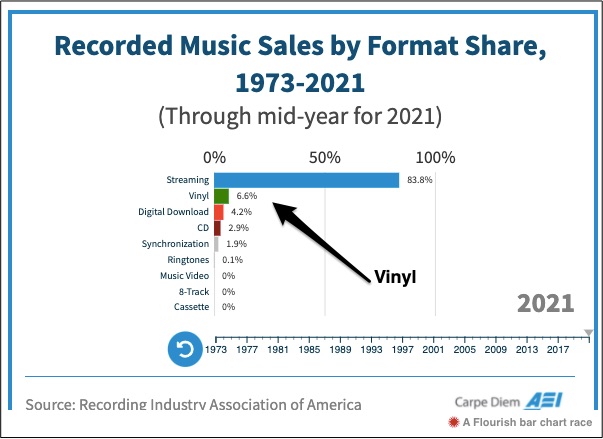Since 1973, the number one spot for record format sales shifted from vinyl to CDs to digital downloads to streaming. Until 1984, vinyl’s share was more than one half but by 1999, it had plunged to .4 percent.
Now, vinyl has made a comeback.

Vinyl Records
During the 1970s, we bought vinyl, 8-track tapes, and cassettes. It took until 1991 for CDs to occupy the #1 spot and then 20 years later digital downloads took over. Amazingly, only 10 years ago, streaming represented just 9.2 percent of all recorded music sales. This year, it is a touch below 85 percent.
The big surprise though is vinyl. With a 49 percent increase over 2013, sales first popped in 2014. From a #4 spot, by 2020, it ascended to #2. The BBC tells us that 2020 vinyl album sales in the U.K. were up by 30 percent to 4.8 million–approximately 4.6 million more than in 2007. Similarly, during the first half of this year, U.S. sales were 17 million records and $467 million in retail revenue. Much less, CD revenue was $204 million.
Quality appears to be one reason for its popularity. When a vinyl record is cut from an analog recording (not digital), the results can be stunning. Perhaps we can add a touch of nostalgia and our desire for “a tactile experience.” The BBC also suggests that vinyl records are sustainable. No, it’s certainly not because of their polyvinyl chloride. Rather, as collectibles, we don’t discard them.
The big challenge now is updating antiquated technology. The NY Times tells us that the industry is using equipment that had been stored for decades. With new machines in a clogged pipeline and Covid compounding delays, the quantity demanded far exceeds the capacity on the supply side.
Our Bottom Line: Creative Destruction
When vinyl topped the list in 1973, ringtones (and streaming) had no place to go. Soon though, creative destruction transformed the industry.
As economist Joseph Schumpeter (1883-1950) explained, entrepreneurs create jobs, progress, and productivity. They change consumer habits, design new means of production, and develop new forms of economic organization. But they also create the pain connected with the demise of old industries as new products and processes replace what had existed.
Through creative destruction, autos replaced the horse and buggy, the light bulb eliminated kerosene lamps, and typewriters disappeared. We could also say that creative destruction is the reason that with new recorded music formats we got convenience, quantity, and affordability.
Sometimes though we just want to go “back to the future.”
My sources and more: The NY Times had the vinyl record update. Meanwhile, WSJ, here and here, and the BBC, had more recent history. However, my starting point for the facts and some economic analysis was one of Mark Perry’s clever animated charts. They tell a story that thousands of words could not convey.
Please note that parts of today’s “Bottom Line” were in past econlife posts.







Love this! I teach about Schumpeter in my public policy classes. I think it is one of the students’ favorite exercises to think of industries that have undergone these kinds of shifts.